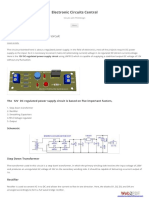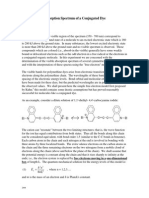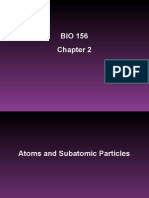Electron Theory
Electron Theory
Uploaded by
Lester CabungcalCopyright:
Available Formats
Electron Theory
Electron Theory
Uploaded by
Lester CabungcalOriginal Description:
Copyright
Available Formats
Share this document
Did you find this document useful?
Is this content inappropriate?
Copyright:
Available Formats
Electron Theory
Electron Theory
Uploaded by
Lester CabungcalCopyright:
Available Formats
Electron Theory
Electron Theory
Electricity is the movement of electrons through a conductor. Electrons
are attracted to protons. Since we have excess electrons on the other
end of the conductor, we have many electrons being attracted to the
protons. This attraction sort of pushes the electrons toward the protons.
This push is normally called electrical pressure. The amount of electrical
pressure is determined by the number of electrons that are attracted to
protons.
The electrical pressure or electromotive force (EMF) attempts to push an
electron out of its orbit and toward the excess protons. If an electron is
freed from its orbit, the atom acquires a positive charge because it now
has one more proton than it has electrons. The unbalanced atom or ion
attempts to return to its balanced state so it will attract electrons from
the orbit of other balanced atoms. This starts a chain reaction as one
atom captures an electron and another releases an electron. As this
action continues to occur, electrons will flow through the conductor. A
stream of free electrons forms and an electrical current is started.
This does not mean a single electron travels the length of the insulator,
it means the overall effect is electrons moving in one direction. All this
happens at the speed of light. The strength of the electron flow is
dependant on the potential difference or voltage.
The three elements of electricity are voltage, current, and resistance.
How these three elements interrelate governs the behavior of electricity.
Once the you comprehend the laws that govern electricity,
understanding the function and operation of the various automotive
electrical systems is an easier task.
So far we have described current as the movement of electrons through
a conductor. Electrons are negatively charged particles that move
toward something that is positively charged. Electrons move because of
this potential difference. This describes one of the common theories
about current flow. The electron theory states that since electrons are
negatively charged, current flows from the most negative to the most
positive point within an electrical circuit. In other words, current flows
from negative to positive. This theory is widely accepted by the
electronic industry.
Another current flow theory is called the conventional theory. This states
that current flows from positive to negative. The basic idea behind this
theory is simply that although electrons move toward the protons, the
energy or force that is released as the electrons move begins at the
point where the first electron moved to the most positive charge. As
electrons continue to move in one direction, the released energy moves
in the opposite direction. This theory is the oldest theory and serves as
the basis for most electrical diagrams.
Trying to make sense of it all may be difficult for you. It is also difficult
for scientists and engineers. In fact, another theory has been developed
to explain the mysteries of current flow. This theory is called the hole-
flow theory and is actually based on both electron theory and the
conventional theory.
Fortunately, it really doesn't matter as long as you know what current
flow is and what affects it. From this understanding you will be able to
figure out how the circuit basically works, how to test it. and how to
repair it.
Remember that current flow is the result of the movement of electrons,
regardless of the theory.
You might also like
- Capacitor - Lab - Basics - HTML - Remote - Lab - SU2020Document16 pagesCapacitor - Lab - Basics - HTML - Remote - Lab - SU2020Mujtaba HassanNo ratings yet
- GENERAL PHYSICS 2 - Q3 - Week 7Document26 pagesGENERAL PHYSICS 2 - Q3 - Week 7ariinnggg onichaNo ratings yet
- 12V DC Regulated Power Supply CircuitDocument4 pages12V DC Regulated Power Supply CircuitHeknath100% (1)
- CH Test 4 PDFDocument151 pagesCH Test 4 PDFcvo123100% (1)
- Lab 5th Assignment About GM CounterDocument9 pagesLab 5th Assignment About GM CounterJamil100% (1)
- Electric FieldDocument7 pagesElectric FieldMark Abordo LabiosNo ratings yet
- ELECTRIC FLUX (Erin)Document16 pagesELECTRIC FLUX (Erin)Mark Francis VillegasNo ratings yet
- Accelerated Uniform Rectilinear MotionDocument7 pagesAccelerated Uniform Rectilinear MotionYanuar Alfa100% (2)
- Magnetic Field and Magnetic ForceDocument21 pagesMagnetic Field and Magnetic ForceRonan EsguerraNo ratings yet
- Ohms LawDocument24 pagesOhms LawCyla Antonio Asirit100% (1)
- Module 2 Electric CurrentDocument14 pagesModule 2 Electric Currentjovy dulay100% (2)
- Electric PotentialDocument26 pagesElectric PotentialGlitchNo ratings yet
- Magnetic Induction and Faradays Law in General Physics 2Document43 pagesMagnetic Induction and Faradays Law in General Physics 2Heidi QuiranteNo ratings yet
- Problem and Solution Electric FieldDocument10 pagesProblem and Solution Electric FieldSansen Diamante Colipano Jr.No ratings yet
- Exp 1 Machines 1Document9 pagesExp 1 Machines 1Ysa JasaNo ratings yet
- Diffraction of LightDocument23 pagesDiffraction of LightSamsam Almarez BacaltosNo ratings yet
- GENERAL PHYSICS 2 - Q3 - Week 2Document22 pagesGENERAL PHYSICS 2 - Q3 - Week 2vrejie46No ratings yet
- Electric Potential Energy Problems and SolutionsDocument1 pageElectric Potential Energy Problems and SolutionsBasic PhysicsNo ratings yet
- Work Energy Practice Quiz AnswersDocument3 pagesWork Energy Practice Quiz AnswersJohn Mark CabicunganNo ratings yet
- Kirchoff's Law Lesson-PlanDocument14 pagesKirchoff's Law Lesson-Plansam bootcampNo ratings yet
- Reflection, Refraction, Dispersion and PolarizationDocument18 pagesReflection, Refraction, Dispersion and PolarizationmacNo ratings yet
- CapacitorsDocument25 pagesCapacitorsAlbert Rosete0% (1)
- Lesson Plan - Direct Current Circuit - Sahal FawaizDocument35 pagesLesson Plan - Direct Current Circuit - Sahal Fawaizsahal fawaizNo ratings yet
- History of MagnetismDocument6 pagesHistory of MagnetismKangNo ratings yet
- GP 1 Module 4Document91 pagesGP 1 Module 4Raymund EspinoNo ratings yet
- GP 2 Lesson 2.1-2.2Document31 pagesGP 2 Lesson 2.1-2.2Jescelle PetonioNo ratings yet
- General Physics2 Lesson 4 PDFDocument2 pagesGeneral Physics2 Lesson 4 PDFJohn Renzo MolinarNo ratings yet
- Physical Science q4 Slm12 1Document15 pagesPhysical Science q4 Slm12 1John Benedict CUSTODIANo ratings yet
- Length ContractionDocument9 pagesLength ContractionkhizarNo ratings yet
- Physics 2 Module 1Document6 pagesPhysics 2 Module 1jnnpctngNo ratings yet
- Measures-English, Metric, and Equivalents PDFDocument1 pageMeasures-English, Metric, and Equivalents PDFJonathanNo ratings yet
- Gnphys+2+ +worktext+ +week+6+ +unit+6Document10 pagesGnphys+2+ +worktext+ +week+6+ +unit+6Nad dlanyer LatigidadNo ratings yet
- General Physics 2: Grade 12Document53 pagesGeneral Physics 2: Grade 12Del Mundo, Jelo ArsuaNo ratings yet
- OHM'S LAW v2Document31 pagesOHM'S LAW v2Katherine Gauuan Liwag0% (1)
- General Physics 2 Module 1Document32 pagesGeneral Physics 2 Module 1GNC Tricia Faye DeleonNo ratings yet
- Electric charGE AND ELECTRIC FIELDDocument20 pagesElectric charGE AND ELECTRIC FIELDsiddhartha2862No ratings yet
- GENERAL PHYSICS 2 - Q3 - Week 8Document19 pagesGENERAL PHYSICS 2 - Q3 - Week 8ariinnggg onichaNo ratings yet
- LAS 3 Gen-Physics 2Document4 pagesLAS 3 Gen-Physics 2Hannah Bianca RegullanoNo ratings yet
- MODULE 3 - Electric Field-Electric Flux-Gauss's LawDocument9 pagesMODULE 3 - Electric Field-Electric Flux-Gauss's LawPatrick CruzNo ratings yet
- Problem Sheet Module 1Document6 pagesProblem Sheet Module 1Mohan B Somashakar100% (1)
- Q4 General Physics 2 STEM 12 Week 1Document38 pagesQ4 General Physics 2 STEM 12 Week 1Personal AccountNo ratings yet
- PHYS 1100 DC Circuits SolutionsDocument14 pagesPHYS 1100 DC Circuits SolutionsYihun TsegayeNo ratings yet
- General Physics 1 Newton'S Laws of Motion: Content Standard Performance StandardDocument10 pagesGeneral Physics 1 Newton'S Laws of Motion: Content Standard Performance StandardJoshua Abuyan100% (1)
- Design and Implementation of Solar Powered Mobile Phone Charging Station For Public PlacesDocument1 pageDesign and Implementation of Solar Powered Mobile Phone Charging Station For Public Placesmarchanalzandra2No ratings yet
- Coulombs Law Practice-1Document1 pageCoulombs Law Practice-1Even JorgensNo ratings yet
- General Physics 2Document14 pagesGeneral Physics 2Frances Ayanna QueddengNo ratings yet
- GP2 PrelimDocument134 pagesGP2 Prelimkmarissee100% (1)
- Lesson 2.2 Gauss LawDocument50 pagesLesson 2.2 Gauss LawKryssha Gabieta0% (1)
- Ohm's LawDocument33 pagesOhm's LawAnn NavarroNo ratings yet
- Capacitors in Series and Parallel LP DONEDocument4 pagesCapacitors in Series and Parallel LP DONEDave Cercado Bugador100% (1)
- Electric Potential and Potential DifferenceDocument14 pagesElectric Potential and Potential DifferenceChristianNo ratings yet
- 25 - Current, Resistance, and Electromotive Force - R K ParidaDocument11 pages25 - Current, Resistance, and Electromotive Force - R K ParidaMonicaNo ratings yet
- Lesson Plan - Antennas & Wave Propagation (15EC604)Document25 pagesLesson Plan - Antennas & Wave Propagation (15EC604)Ramya100% (1)
- Lesson Plan Genral Physics 2Document4 pagesLesson Plan Genral Physics 2Ron Dela RosaNo ratings yet
- General Physics 2 Q4-Module 1Document16 pagesGeneral Physics 2 Q4-Module 1Lovelyjoy MarianoNo ratings yet
- CH 21 PPT LectureDocument82 pagesCH 21 PPT LectureNidonama E. KabmatNo ratings yet
- Quarter I - Module 3: Electronic CircuitsDocument16 pagesQuarter I - Module 3: Electronic CircuitsJonash Miguel LorzanoNo ratings yet
- Chap4 Ohms Law Power EnergyDocument43 pagesChap4 Ohms Law Power Energytolera100% (1)
- General Physics 2 Quarter 3: Week 7 - Module 7: Magnetic Field VectorDocument15 pagesGeneral Physics 2 Quarter 3: Week 7 - Module 7: Magnetic Field VectorJun DandoNo ratings yet
- Electric Potential EditedDocument32 pagesElectric Potential EditedPororo 3701No ratings yet
- Fundamental of Electricity and MagnetismDocument18 pagesFundamental of Electricity and MagnetismVedant KamlaskarNo ratings yet
- Ee421 Module 1Document39 pagesEe421 Module 1Eirish Chrystelle EsmasNo ratings yet
- 24-0117 RBF BTS ASURION - Presentation Material - REV 01Document46 pages24-0117 RBF BTS ASURION - Presentation Material - REV 01Lester CabungcalNo ratings yet
- Vermicomposting Final Proposal - Final Offer 070224Document8 pagesVermicomposting Final Proposal - Final Offer 070224Lester CabungcalNo ratings yet
- CMG Bid Evaluation Criteria and Scoring - Rehabilitiation of FPIP Gate 2 and Ulango Gate-Final.Document1 pageCMG Bid Evaluation Criteria and Scoring - Rehabilitiation of FPIP Gate 2 and Ulango Gate-Final.Lester CabungcalNo ratings yet
- 2205AB-03-AR-104-0 - Schedule of Doors and WindowsDocument1 page2205AB-03-AR-104-0 - Schedule of Doors and WindowsLester CabungcalNo ratings yet
- Santo Tomas Order of PaymentDocument1 pageSanto Tomas Order of PaymentLester CabungcalNo ratings yet
- Plumbing EstimateDocument6 pagesPlumbing EstimateLester CabungcalNo ratings yet
- Vermicomposting AreaDocument10 pagesVermicomposting AreaLester CabungcalNo ratings yet
- 2205AB-03-AR-201 - 0 - General Notes, Legends & Symbols, Guard House Speaker and Smoke Detector Layout-Layout 1Document1 page2205AB-03-AR-201 - 0 - General Notes, Legends & Symbols, Guard House Speaker and Smoke Detector Layout-Layout 1Lester CabungcalNo ratings yet
- Date 1 Reading Salmo 2 Reading PL Commentator: ST NDDocument1 pageDate 1 Reading Salmo 2 Reading PL Commentator: ST NDLester CabungcalNo ratings yet
- Materials Unit Price: Cement Sand Gravel (1", ") Rebar (Grade 40, Grade 60) Tie Wire (Ga. 16) Phenolic BoardDocument1 pageMaterials Unit Price: Cement Sand Gravel (1", ") Rebar (Grade 40, Grade 60) Tie Wire (Ga. 16) Phenolic BoardLester CabungcalNo ratings yet
- Cashier Pay Here: Toyo Suka PatisDocument1 pageCashier Pay Here: Toyo Suka PatisLester CabungcalNo ratings yet
- Envi and Proj. ConstraintsDocument3 pagesEnvi and Proj. ConstraintsLester CabungcalNo ratings yet
- Moa CondevDocument5 pagesMoa CondevLester CabungcalNo ratings yet
- Materials Unit Price: Portland Cement Sand Gravel (1", ") Rebar (Grade 40, Grade 60) Tie Wire (Ga. 16) Phenolic BoardDocument1 pageMaterials Unit Price: Portland Cement Sand Gravel (1", ") Rebar (Grade 40, Grade 60) Tie Wire (Ga. 16) Phenolic BoardLester CabungcalNo ratings yet
- Dead LoadDocument3 pagesDead LoadLester CabungcalNo ratings yet
- Frequently Asked Questions About RA 9184Document18 pagesFrequently Asked Questions About RA 9184Lester CabungcalNo ratings yet
- ProcurementDocument30 pagesProcurementLester CabungcalNo ratings yet
- Chapter 15 Retaining Walls and Braced CutsDocument6 pagesChapter 15 Retaining Walls and Braced CutsLester CabungcalNo ratings yet
- Group No. 14Document3 pagesGroup No. 14Lester CabungcalNo ratings yet
- Fucking Case StudyDocument13 pagesFucking Case StudyLester CabungcalNo ratings yet
- Balayan D1Document11 pagesBalayan D1Lester CabungcalNo ratings yet
- Midterm Exam CMTDocument13 pagesMidterm Exam CMTLester CabungcalNo ratings yet
- Basi C: Stat ICS Stati CS Stat ICSDocument2 pagesBasi C: Stat ICS Stati CS Stat ICSLester CabungcalNo ratings yet
- G-Cakna Kelantan 2015 - Physics Term 2 - Module 2Document12 pagesG-Cakna Kelantan 2015 - Physics Term 2 - Module 2annahiazNo ratings yet
- Law of Attraction TipsDocument32 pagesLaw of Attraction TipsaldentulkoNo ratings yet
- PhysicsDocument32 pagesPhysicsDan Sebastian TilaoNo ratings yet
- Aqa Pa01 W QP Jan05Document13 pagesAqa Pa01 W QP Jan05fakeusername01No ratings yet
- 3101 Physics Paper With Answer MorningDocument5 pages3101 Physics Paper With Answer Morningmonishbro41No ratings yet
- CHEM442 Lecture37Document29 pagesCHEM442 Lecture37fathur fikranNo ratings yet
- Universe - WikipediaDocument19 pagesUniverse - WikipediaTejasNo ratings yet
- Ap Chem Unit 1 Review PacketDocument10 pagesAp Chem Unit 1 Review Packetapi-77411869No ratings yet
- (30-Second) Charles Liu, Karen Masters, Sevil Salur - 30-Second Universe - 50 Most Significant Ideas, Theories and Events That Sum Up Everything (2019, Ivy Press) - Libgen - LiDocument163 pages(30-Second) Charles Liu, Karen Masters, Sevil Salur - 30-Second Universe - 50 Most Significant Ideas, Theories and Events That Sum Up Everything (2019, Ivy Press) - Libgen - LiFinbarr100% (2)
- Sub-Atomic ParticlesDocument15 pagesSub-Atomic ParticlesAmber MichaelsNo ratings yet
- Metallic BondingDocument28 pagesMetallic BondingLysha Kana-an CarampatanaNo ratings yet
- Static Electricity LabDocument6 pagesStatic Electricity LabVICTOR AXEL GARRICO HERNANDEZNo ratings yet
- Measurement of Gas Bremsstrahlung From Electron Storage RingsDocument21 pagesMeasurement of Gas Bremsstrahlung From Electron Storage RingsYoussef HusseinNo ratings yet
- Why Mercury Liquid?: Or, Why Do Relativistic Effects Not Get Into Chemistry Textbooks?Document4 pagesWhy Mercury Liquid?: Or, Why Do Relativistic Effects Not Get Into Chemistry Textbooks?leonardo_strajaneliNo ratings yet
- Lecture 1 - Chapter 1 (Basic Concepts)Document55 pagesLecture 1 - Chapter 1 (Basic Concepts)Saleh AlhalgpiNo ratings yet
- Storage and Display DevicesDocument88 pagesStorage and Display DevicesSenthil Murugan100% (1)
- (NagpurStudents - Org) Advanced PhysicsDocument4 pages(NagpurStudents - Org) Advanced PhysicsVaibhav NardangeNo ratings yet
- Lab. Conjugated DyesDocument5 pagesLab. Conjugated DyesIreneVeladoNo ratings yet
- Energy Levels in One DimensionDocument13 pagesEnergy Levels in One DimensionSaiia GusttiNo ratings yet
- Chem 209 Lecture 1Document178 pagesChem 209 Lecture 1Rab BaloloyNo ratings yet
- BIO 156 Chapter 2 PowerpointDocument24 pagesBIO 156 Chapter 2 PowerpointDrPearcyNo ratings yet
- Hamrle - Spin Orbit CouplingDocument19 pagesHamrle - Spin Orbit Couplingsushil kumarNo ratings yet
- Common Idioms and ExpressionsDocument184 pagesCommon Idioms and ExpressionsHéctor AnderNo ratings yet
- Electric Field and CapacitorsDocument18 pagesElectric Field and CapacitorsTharushiNethmiNo ratings yet
- (English) Particles and Waves - The Central Mystery of Quantum Mechanics - Chad Orzel (DownSub - Com)Document4 pages(English) Particles and Waves - The Central Mystery of Quantum Mechanics - Chad Orzel (DownSub - Com)SatAprNo ratings yet
- Cambridge International AS & A Level: Physics 9702/21Document16 pagesCambridge International AS & A Level: Physics 9702/21LINH DUONGNo ratings yet
- Koopmans 2005Document4 pagesKoopmans 2005gmask100No ratings yet
- Tailoring The Electron and Hole Land e Factors in Lead Halide Perovskite Nanocrystals by Quantum Confinement and Halide ExchangeDocument18 pagesTailoring The Electron and Hole Land e Factors in Lead Halide Perovskite Nanocrystals by Quantum Confinement and Halide ExchangefwfwNo ratings yet
















































































































